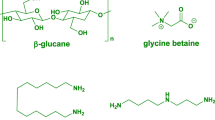Abstract
The use of bioinsecticides, particularly those produced by sporeless Bacillus thuringiensis strains, has been shown to be a good alternative in pest management. Two types of sporeless mutants were distinguished. The asporogenic mutants which completely lack spores produce a regular bipyramidal crystal inclusion. The oligosporogenic mutants kept the ability to produce insecticidal crystal proteins. However, sporulation in such mutants was not totally blocked and very few of them could still produce spores. In order to improve bioinsecticides production, adaptation of sporeless strains to heat shock and osmotic stress was investigated. Delta-endotoxin production by 78% of sporeless mutants was significantly improved by osmotic stress with an overproduction of about 17%, compared to the wild strain BNS3. However, toxin production was improved by only 21% of mutants after heat shock, in low cost medium. The statistical analysis proved that delta-endotoxin production, cell growth, and spore formation of asporogenic and oligosporogenic mutants depended on the type of applied stress. Each strain has an important potential when applying the adequate stress. Moreover, adaptation of sporeless mutants to NaCl may allow the substitution of all minerals of the medium by diluted sea water which appeared to be a good alternative for the economic production of bioinsecticides at industrial scale which is of great importance from the practical point of view.
Similar content being viewed by others
References
Amezega MR, Davidson I, McLaggan D, Verheyul A, Abee T, Booth I (1995) The role of peptide metabolism in the growth of Listeria monocytogenes ATCC 23074 at high osmolarity. Microbiology 141:41–49
Ben Khedher S, Zouari N, Messaddeq N, Schultz P, Jaoua S (2010) Overproduction of delta-endotoxins by sporeless Bacillus thuringiensis mutants obtained by nitrous acid mutagenesis. Curr Microbiol 62:38–43
Bradford MM (1976) A rapid and sensitive method for the quantification of microgram quantities of protein utilising the principle of protein-dye binding. Anal Biochem 72:248–254
Ghribi D, Zouari N, Jaoua S (2004) Improvement of bioinsecticides production through mutagenesis of Bacillus thuringiensis by U.V. and nitrous acid affecting metabolic pathways and/or delta-endotoxin synthesis. J Appl Microbiol 97:338–346
Ghribi D, Zouari N, Jaoua S (2005) Improvement of bioinsecticides production through adaptation of Bacillus thuringiensis cells to heat treatment and NaCl addition. J Appl Microbiol 98:823–831
Ghribi D, Zouari N, Trigui W, Jaoua S (2007) Use of sea water as salts source in starch and soya bean based media, for the production of Bacillus thuringiensis bioinsecticides. Process Biochem 42:374–378
Herbert RA (1986) The ecology and physiology of psychrophilic microorganisms. In: Herbert RA, Codd GA (eds) Microbes in extreme environments. The Society for General Microbiology, Academic Press, London, pp 1–4
Jaoua S, Zouari N, Tounsi S, Ellouz R (1996) Study of the delta-endotoxins produced by three recently isolated strains of Bacillus thuringiensis. FEMS Microbiol Lett 145:349–354
Morries ON, Converse V, Kanagaratnam P, Davies JS (1996) Effect of cultural conditions on spore-crystal yield and toxicity of Bacillus thuringiensis subs. aizawai HD133. J Invertebr Pathol 67:129–136
Ruzal SM, Alice AF, Sanchez-Rivas C (1994) Osmoresistance of spores from Bacillus subtilis and the effects of ssp mutations. Microbiology 140:2173–2177
Schnepf E, Crickmore N, Van Rie J, Lereclus D, Baum J, Feitelson J, Zeigler D, Dean D (1998) Bacillus thuringiensisits pesticidal crystal proteins. Microbiol Mol Biol Rev 62:775–806
Setlow PI (1993) Will survive: protecting and repairing spore DNA. J Bacteriol 174:2737–2741
Tounsi S, Dammak M, Rebaî A, Jaoua S (2005) Response of larval Ephestia kuehniella (Lepidoptera: Pyralidae) to individual Bacillus thuringiensis kurstaki toxins and toxin mixtures. Biol Control 35:27–31
Venables WN, Smith DM (2004) The R. development core team. An introduction to R. version 1.9.1. http://www..r-project.org/
Zouari N, Dhouib A, Ellouz R, Jaoua S (1998) Nutritional requirements of a strain of Bacillus thuringiensis subsp kurstaki and use of gruel hydrolysate, for the formulation of a new medium for delta-endotoxin production. Appl Biochem Biotechnol 69:41–45
Zouari N, Ben Sik Ali S, Jaoua S (2002) Production of delta-endotoxin by several Bacillus thuringiensis strains exhibiting various entomocidal activities towards lepidoptera and diptera in gruel and fish-meal media. Enzyme Microb Technol 31:411–418
Acknowledgments
This study was supported by grants from the “Tunisian Ministry of Higher Education, Scientific Research and Technology”.
Author information
Authors and Affiliations
Corresponding author
Rights and permissions
About this article
Cite this article
Ben Khedher, S., Jaoua, S. & Zouari, N. Improvement of Bioinsecticides Production by Sporeless Bacillus thuringiensis Strains in Response to Various Stresses in Low Cost Medium. Curr Microbiol 62, 1467–1477 (2011). https://doi.org/10.1007/s00284-011-9884-6
Received:
Accepted:
Published:
Issue Date:
DOI: https://doi.org/10.1007/s00284-011-9884-6




